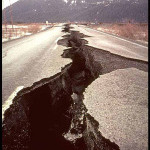Created by: Silentchapel
Number of Blossarys: 95
In geology, a fault is a planar fracture or discontinuity in a volume of rock, across which there has been significant displacement along the fractures as a result of earth movement. Large faults ...
An earthquake's hypocenter is the position where the strain energy stored in the rock is first released, marking the point where the fault begins to rupture. This occurs directly beneath the ...
The epicenter or epicentre is the point on the Earth's surface that is directly above the hypocenter or focus, the point where an earthquake or underground explosion originates. In the case of ...
Seismometers are instruments that measure motions of the ground, including those of seismic waves generated by earthquakes, volcanic eruptions, and other seismic sources. Records of seismic waves ...
Seismic waves are waves of energy that travel through the Earth's layers, and are a result of an earthquake, explosion, or a volcano that imparts low-frequency acoustic energy. Many other natural ...
An earthquake (also known as a quake, tremor or temblor) is the result of a sudden release of energy in the Earth's crust that creates seismic waves. The seismicity, seismism or seismic activity ...


 English (EN)
English (EN) 




